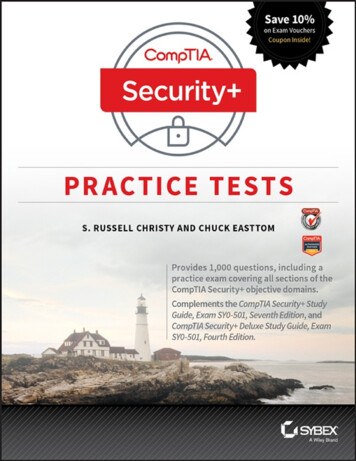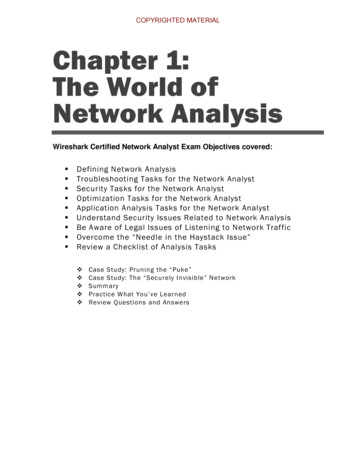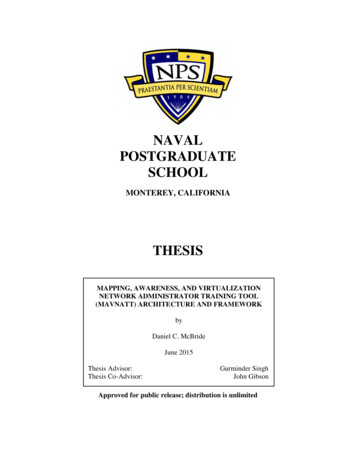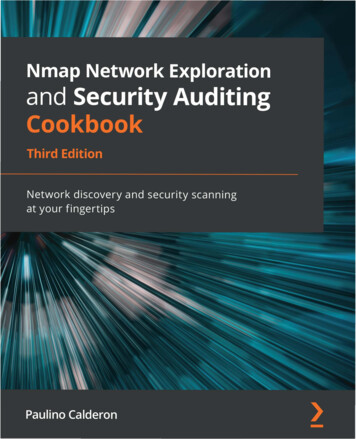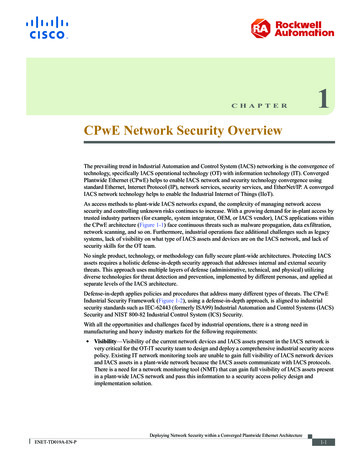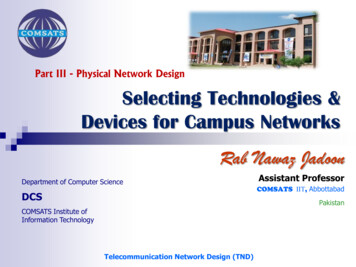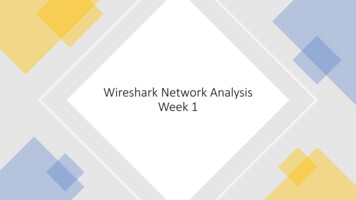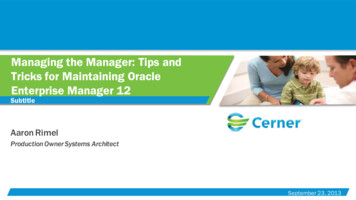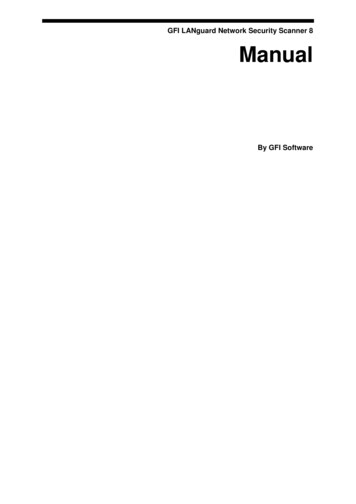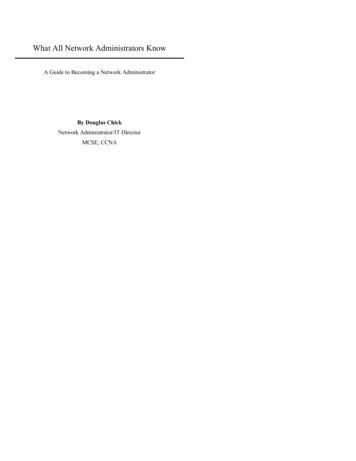
Transcription
What All Network Administrators KnowA Guide to Becoming a Network AdministratorBy Douglas ChickNetwork Administrator/IT DirectorMCSE, CCNA
Copyright 2003 by Douglas Chick. All Rights Reserved.Published by The Network Administrator.comNo part of this publication may be reproduced, stored in retrievalsystem, or transmitted in any form by any means, electronic,mechanical, photocopying, recording, scanning, or otherwise, except aspermitted under Section 107 or 108 of the 1976 United StatesCopyright Act, without either the prior written permission of thePublisher, or authorization through payment of the appropriate percopy fee to DouglasChick@TheNetworkAdministrator.comISBN 0-9744630-0-0Publisher strator.comSchlaine Chudeusz, Editor
Table of Contents Preface . Who Should Read This Book 3 What is a Network Administrator 3 How Much Does a Network Administrator Make . 5 Can I Get a Job as a Network Administrator1Without Experience . 7 Do I Have to Get a Degree Or Can I Just GetNetwork Certifications 10 Can I Quit My Job, Go To a CertificationBoot Camp and Make 70K . 13 Being a Brave Liar . 15 Do I Have To Be Good At Math . 17 Learning Under Fire or Submersion Learning 18 Know Your Servers . 20 Know The Server Room . 26 What Server Operating System Should I Know . 30 What To Do When a Server Crashes . 32 What To Know About Viruses 38 What To Know About Security . 41 What To Know About E-mail Servers 50 What Type of Software Should I Know ToBe a Network Administrator . 51
Client Side . 51 Server Side . 57 Troubleshooting . 59 Tools of The Network Administrator . 61 Command Line Utilities . 65 Upgrades . 67 The Preceding Network Administrator . 68 Being Good at Prioritizing 70 Proprietary Software . 73 Working Without Supervision 74 Salaried Position . 75 Specialist and Generalist 76 Writing Network and Internet Policy . 79 Software Licenses . 80 Training Yourself and Your Staff . 81 Communication . 83 What You Need To Know About Computer End Users . 84 Repairing Home Computers . 88 Most Common Mistakes Made By New Admins 89 Being a Network Administrator 91 Who Has The Power 97 The Interview That Gets You The Job 99 Conclusion . 99 About The Author . 100
What All Network Administrators KnowPrefaceThis book is in response to the daily e-mails I receivefrom my website www.thenetworkadministrator.comthat ask the question; “What do I need to know tobecome a network administrator?” Some of you readingthis book might find that you have all the qualificationsneeded, while others may become easily discouraged.Don’t be discouraged. Nothing long lasting or worthhaving such as a professional career can happenovernight. As an experienced network administratorand a computer professional I can help you avoid thepitfalls that I see many new computer people encounterand help you realize your objective by making youmore employable, by knowing what you can expect as anetwork administrator and the types of programs youwill be expected to know. The problem with mostbooks on computers and networking is they are thickwith trivial data that either doesn’t help you get a job ordoesn’t tell you what to do once you have one. What AllNetwork Administrators Know is a short book that is tothe point from a network manager’s perspective. All thebooks that you’ve read about computers andnetworking before this one addressed configurations,program usage and enough acronyms to fill a popularvegetable soup can. This book addresses what youshould know before you interview and what you shouldexpect once you have the job.As you may have already discovered, there are not alot of resources on the Internet or from your school oruniversity that address how to become a networkadministrator. Though there is a network administrator1
What All Network Administrators Knowin every company with computers in the world, andthere are million of us, no one addresses any of thebasic questions associated with the job. This is why Ihave a site for network administrators and is preciselythe reason for this book. As an experienced networkadministrator, I can give you valuable insight and helpguide you in the direction that you need to collect theknowledge and tools to advance your career. I willaddress not only the basic fundamentals, but whichoperating systems will help you find a job faster, thereal tools that you will need to help you do your job,and the corporate politics within every company that israrely discussed outside of a group therapy session.When you finish reading this you will either be chargedup and ready to get started, or realize you’d ratherpursue that Liberal Arts Degree that your high schoolguidance counselor once spoke of.There is a lot to know to be a networkadministrator, and reading this book might make isseem a bit overwhelming. It is not my intention todiscourage anyone from being a network administrator.For many people, including myself, this is one of thegreatest jobs you can have, but I’m not going to sugarcoat it either. Being a network administrator can behard and very demanding. Most books aboutnetworking only tell you how to configure software,this book will tell you what to expect when you get thejob. 2
What All Network Administrators KnowWhat To Do When a Server CrashesThere is no drug or single event in the world that canmake a computer person focus more clearly than whena server crashes. The mere act of a crashing hard drive,database or server component can temporarily raiseone’s IQ as much as 50 points. You suddenly becomemore aware of the universe around you and less awareof trivial aspects in life, such as reality TV, what typeof car you should drive and if wearing socks withsandals is cool. You can for a brief moment see dimlyinto the immediate future as your pleasure centerstemporarily shutdown and you put your resume onstandby for a mass mailing campaign. You move muchquicker as time seems to slow down, you can calculaterational and irrational numbers using math that hasn’tbeen invented yet and you become a little morespiritual—no, a lot more spiritual. A crashed serversometimes brings a network administrator closer toGod, his or her fellow workers and the unemploymentline. And in a single point of light (pixilated light) whenyou discover that your backups haven’t run for overtwo months, a cold perspiration blankets your feverousbody while your knees weaken and the contents of yourstomach climb to the top of your reflux valve. This is it;your mission critical server crashed and you don’t havea backup. So what do you do next? You do what everynetwork administrator does when this happens; youcalmly walk into your office, throw up in your trashcanand slowly begin gathering up your personal itemswhile waiting for someone from Human Resources tobring you a box. And as you sit at your desk trying to32
What All Network Administrators Knowfigure out how you’re going to get 2 gigs of MP3s toyour home computer it hits you like a brick—you readthis book and configured a redundant backup to anotherserver on another hard drive. Suddenly the feeling inyour hands and feet return and you go back to theserver room and restore the data.When a server crashes and you don’t have a currentbackup you are fired. When a hard drive crashes andyou don’t have a backup you are fired. And when thereis a fire in your server room and all of the company’sdata is lost to fire, you are fired. Twice in my career ahard drive has crashed with critical company data on itand I didn’t have a current backup to restore from.Backup software is not as reliable as many companieswill lead you to believe. You should pick a day everyweek to check if your backups are successfully. I’vemade it a habit to check my backups every Mondaywithout fail. Because if you don’t you know the rest.Another issue with backups is that you don’t alwaysknow what should be backed up. It’s a nice thought tohave every drive on every server backed up every night,but in reality it’s just not feasible. At my company, wehave every server operating system imaged to a CDROM. If the server crashes, we can have another onere-imaged and up before you can restore from tape.Now all that’s left to do is restore data files. When youare new to a company, it is almost impossible to guesswhat should and shouldn’t be backed up. The best youcan do is back up everything that looks like a data fileand bring the head of every department in to show youwhat needs backing up. The first drive that crashed onme without a backup was the marketing department is33
What All Network Administrators KnowMacintosh drive. I didn’t see it, I didn’t know it wasthere and when it was lost there was someone theretrying to monopolize on the situation for my job. Sodon’t leave it up to guess-work, bring in someone fromevery department to help you. Later you will bethankful that you shared the responsibility. If yourcompany manager tells you to back up everything, thenthey are going to have to invest in the properequipment.Types of BackupsFull includes files whether they have been changedor not; Differential includes all files changed since the lastfull backup, whether they have been changed since thelast backup operation or not; Incremental includes only those files that havechanged since the last backup operation of any kind. To choose which method of the above types of backupsdepends on three factors: the size of your tape, theperiod of time available for backups, and how long youwant your restore to take.A Full Backup on a daily basis requires a lot of tapeand needs a longer duration to run. I’ve seen backupsthat start late at night and finish in the next afternoon,only to pause for a short breather and start34
What All Network Administrators KnowWhat to know about SecuritySecurity is as important to your network as backups andcorporate managers see little value in the necessarytools to keep your network safe until somethinghappens. But what tools are there to help protect againstintruders? These range from Firewalls, VPNs, IntrusionDetection software, Honeypots, Auditing, Forensicstools, Anti-virus and Anti-Spam for network protection.There are Vulnerability testing software and portscanners, Access Control Lists (ACL), DemilitarizedZones (DMZ), Proxy and Packet Filtering CryptoCapable Routers.Firewalls – Typically a Firewall will sit as a sentry thatconnects your network to the rest of the world.Firewalls will analyze data packets and comparerequests against a pre-configured security list. Manynetwork administrators configure their routers withsecurity access-lists to avoid the necessity of a Firewall.Firewalls can also slow down access speeds because itinspects every packet. Checkpoint -One of the most popular softwarebased firewalls. NetScreen - An excellent hardware based firewallthat keeps your traffic moving at line speed.Symantec Firewall/VPN Appliance An integratedsecurity and networking device that provides easysecure, and cost-effective Internet connectivity betweenlocations.41
What All Network Administrators Know Fortinet Dedicated hardware/software platforms thatbreak the Content Processing Barrier, supportingnetwork-based deployment of application-level services- including virus protection and full-scan contentfiltering - and enabling organizations to improvesecurity, reduce network misuse and abuse, and betterutilize their communications resources, withoutcompromising network performance. Zone Alarm Provides solid, basic PC protection forthe home user. An intuitive user interface that makesfirewall management easier than ever, as well as a hostof security enhancements. And Zone Alarm is free forpersonal use. Excellent for VPN users, too.Virtual Private Networks (VPN) – Virtual privatenetworks provide an encrypted connection between auser's distributed sites over a public network (e.g., theInternet). By contrast, a private network uses dedicatedcircuits and encryption. The basic idea is to provide anencrypted IP tunnel through the Internet that permitsdistributed sites to communicate securely. Theencrypted tunnel provides a secure path for networkapplications and requires no changes to the application.Proxy Servers – A server that sits between a clientapplication such as a Web browser, and a real server. Itintercepts all requests to the real server to see if it canfulfill the requests itself. If not, it forwards the requestto the real server.Linux -- servers have a great built-in proxy program.Here’s a good link on the net that does a good job42
What All Network Administrators Knowexplaining how to configure a proxy server O.htmlWingate -- is popular proxy software for Windows:http://www.wingate.com/Access Lists – An access list is generally associatedwith a router or a computer that is acting as a Firewall.Simply put, an access list either accepts or rejectsaccess to network resources as per configured in itstables. A Cisco router utilizes access list as a securitymeasure to either route traffic to its intended destinationor reject it by sending it to a bit bucket. (A null portconfigured to route a packet to nowhere instead ofwasting resources by rejecting it to it’s originator.)Demilitarized Zone (DMZ) – is a computer or smallsubnetwork that sits between a trusted internal network,such as a corporate private Local Area Network, and anuntrusted external network, such as the public Internet.Typically, the DMZ contains devices accessible toInternet traffic, such as Web (HTTP) servers, FTPservers, SMTP (e-mail) servers and DNS servers. Theterm comes from military use, meaning a buffer areabetween two enemies.43
What All Network Administrators KnowHoneypots & Tar Pits– An Internet attached serverthat acts as a decoy, luring in potential hackers in orderto study their activities and monitor how they are ableto break into a system. Honeypots are designed tomimic systems that an intruder would like to break intobut limit the intruder from having access to an entirenetwork. If a honeypot is successful, the intruder willhave no idea that s/he is being tricked and monitored.Most honeypots are installed inside a firewall so thatthey can better be controlled, though it is possible toinstall them outside of firewalls. A honeypot in afirewall works in the opposite way that a normalfirewall works: instead of restricting what comes into asystem from the Internet, the honeypot firewall allowsall traffic to come in from the Internet and restricts whatthe system sends back out. If you want to learn moreabout “Honeypots” and “How to Create a Honeypot”follow the links spAuditing – Event auditing is used to log eitherequipment or security actions such as deleted files,failed logons and sometimes unauthorized tampering.Event auditing can be used to prevent security break-insor forensics work after the fact when it is too late.44
What All Network Administrators KnowSniffers – A program and/or device that monitors datatraveling over a network. Sniffers can be used both forlegitimate network management functions and forstealing information off a network. Unauthorizedsniffers can be extremely dangerous to a network'ssecurity because they are virtually impossible to detectand can be inserted almost anywhere. This makes thema favorite weapon in the hacker's arsenal and a networkadministrator.Commview – Commview is one of my favorite snifferprograms. Unlike the others I’ve used it displays liveresults and is sell.cgi?item 1526-5&affiliate 18752Ethereal – Ethereal is a free network protocol analyzerfor Unix and Windows. It allows you to examine datafrom a live network or from a capture file on disk.http://www.ethereal.com/WinPcap – WinPcap is another free network analyzer.If you are going to be a network administrator orengineer, another of these programs is a good start tolearning m45
What All Network Administrators KnowPort Scanners – Every computer program and utilitythat is designed to interact with a network is alsoassigned a specific port number. A port number canrange from 1 to whatever the designer assigns. Yourbrowser uses port 80 because this is the numberassigned to HTTP. FTP is 21, mail or SMTP is 110 or25 for POP3. Because ports are the entrance in anynetwork-ready device, they have to sometimes beblocked off to prevent intrusion. This is where a portscanner comes into place. It can be aimed at a single IPaddress or an entire network to scan to see which portsare open and available. Because of this, many networkadministrators limit the number of ports to be used.There are several methods to closing off port access,either by blocking them on your workstation or server,through a security access-list from a router or firewall,or using port translation. (Port translation is where allin- coming requests for port 80 are translated to port2080.) A network administrator uses a port scanner totest his or her network as well as a hacker. Follow thisLINK to a series of FREE Scanning tools.http://www.foundstone.com/index.htm?subnav resources/navigation.htm&subcontent /resources/freetools.htm46
What All Network Administrators KnowWhat types of Attacks can be expected on mynetwork?Attacks against IP are the most common method ofpenetrating a node because it is the network protocol ofthe Internet. For any type of computer equipment toparticipate on the Internet it requires a valid IP Addressand a Hardware Address. The network card makerburns a hardware address onto every network card. Thisnumber is unique to every other network and isexpressed in a hexadecimal value. An IP Address isalso unique and is either assigned statically ordynamically by your Internet provider. An IP Addresscan be tracked to its origination point to where it entersthe Internet. This is where many hackers use some formof IP Spoofing. IP Spoofing is when someonepurposely uses a forged IP Address so their exploitscannot be tracked back to their computer or location. IPand ARP (Hardware Addresses) are commonly spoofedalthough these days I don’t know how effective it is.Denial-of-Service – On the Internet, a denial of service(DoS) attack is an incident in which a user ororganization is deprived of the services of a resourcethey would normally expect to have. Typically, the lossof service is the inability of a particular networkservice, such as e-mail, to be available or the temporaryloss of all network connectivity and services. In theworst cases, for example, a Web site accessed bymillions of people can occasionally be forced totemporarily cease operation. A denial of service attackcan also destroy programming and files in a computer47
What All Network Administrators Knowsystem. Although usually intentional and malicious,denial of service attack can sometimes happenaccidentally. A denial of service attack is a type ofsecurity breach to a computer system that does notusually result in the theft of information or othersecurity loss. However, these attacks can cost the targetperson or company a great deal of time and money.Buffer Overflows – A buffer overflow occurs when aprogram or process tries to store more data in a buffer(temporary data storage area) than it was intended tohold. Since buffers are created to hold a specificamount of data, the extra information—which has to gosomewhere—can overflow into the adjacent buffers,corrupting or overwriting the valid data stored. Inbuffer overflow attacks, the extra data may containcodes designed to trigger specific actions, in effectsending new instructions to the attacked computer thatcould, for example, damage the user's files, changedata, or disclose confidential information.Data Diddling -- This kind of an attack involvesaltering the raw data just before a computer processes itand then changing it back after the processing iscompleted.E-mail Spoofing – A spoofed e-mail is one thatappears to originate from one source but actually hasbeen sent from another source.Spammers utilize this type of spoofing from mailservers that allow open forwarding. Because most48
What All Network Administrators Knowcompanies do not employ an E-mail Administrator,most network administrators don’t know to close thisvulnerability.Worm / Virus Attack – This form of Virus is aprogram that attaches to a computer or a file and thenpropagates to other files and computers on a network.Logic Bombs -- This is an event-dependent programthat relies on a specific event such as a date to triggerthe execution of the virus. (Like the Chernobyl virus).Password Cracking – Password cracking isn’t acomplex procedure, as many people would think. I cantell you from experience that more than half of allpasswords within a company are identical to any othercompany. People tend to use the same passwords aswell as do network administrators. Most of the time,password cracking is more like password guessing. Anetwork is only as secure as its passwords. Passwordsare an ineffective security measure. They don’t keepout the internal or external hackers, pranksters andcriminals (there’s software that can guess ½ thepasswords in an average organization in only a coupleof hours); Passwords are an administrator’s nightmare.Users are constantly forgetting their password, eventhough it is typically their child or pet’s name. Thereare many network administrators that force passwordexpirations. This means that they’ve configured theserver to expire passwords and force the users tochange to a new password as a means of security. It isin my opinion that this practice causes more work for49
What All Network Administrators Knowthe network administrator than it does protecting thenetwork.Confidentiality Breaches – It is reported that 90percent of all security breaches are from the inside byemployees. It is not uncommon to be asked to monitorcompany e-mail to help protect a company fromlawsuits and valuable information being sent outsidethe company. I’ve seen everything you could possiblyimagine from monitoring e-mail, pictures of hairybabies, adultery to embezzlement. For this reason mostcorporations monitor e-mail and if this surprises you, itis only because you haven’t been careful yourself.Every packet of data that leaves and enters your routeris most likely being monitored from either within yourcompany itself or from outside entities.What to Know About E-mail ServersThere are three types of mail servers that you should beaware of, MS Exchange, Send Mail and Lotus Notes.These are the three systems most commonly in use. If Ihad to suggest a mail server to try to learn I wouldselect a Linux based mail server because they are themost common to the net and growing daily.50
What All Network Administrators m/apps/support/Tools of the Network AdministratorPing – The ping utility is typically embedded into thecomputers operating system and is used to test aTCP/IP connection. If you are having connectivityissues here is a quick tip to follow: First ping your local loopback address, [ping127.0.0.1] if you don’t get a successful reply there is aproblem with your TCP/IP configuration on the localcomputer. Un-install and then Re-install the TCP/IPService. If your ping was successful next ping anotheraddress on your same network. If you can ping yourloopback but not another computer on your network,check your cable connection or see if your subnet maskis correct. If you can successfully ping your loopback,and a computer on the same network but cannot pingoutside of your network, then your default gateway iswrong. Here are a gaggle of ping utilities if you don’tlike it the old fashion race Route – Use trace route, or tracert in DOS on aMicrosoft computer, to help in troubleshootingconnectivity issues. Trace route is used to track the pathof out going packets to see which routers they do anddo not pass though. Many times a network problem61
What All Network Administrators Knowmay lie on a remote network and trace route shows youthe last successful hop.Programs like Visual Route http://visualroute.com/ willgive you a graphical view of where your target is andshows you a visual path.Telnet – Telnet is a utility used to connect to a router orremote computer. Finding a Telnet program that youare comfortable with is important. I liked the one thatcame with Windows 98 or NT Server. I don’t like thetelnet program packaged in XP or Windows 2000. I’vecopied the old telnet program from NT and placed it onmy laptop. Hackers typically use telnet to gain access torouters and test open and closed ports.Protocol Analyzers – A protocol analyzer, or sniffer asmost people will call it, is used to examine data packetsentering and exiting your network. A sniffer can showyou what traffic is dominating your network, fromwhich computer sources and if someone is running aport scanner on any of your systems. Sniffer Pro is agood sniffer program but it has always been tooexpensive for me. Recently I found a program calledCommview that I love. Very few computer people willspend their own money for software, but I did withCommview. Most operating systems come with theirown packet analyzers, but they are basic and oftenclumsy to use. I prefer a real time program so I products/commview/62
What All Network Administrators KnowNSLOOKUP – is a program that quires a company’sDNS server and resolves hostnames, aliases and mailexchanges. Hackers will sometimes use NSLOOKUP toprofile the naming convention of a company. Here is anonline tool to help you get the feel for what this utilitydoes. http://www.trulan.com/nslookup.htmWhois – Finds information about an IP address orhostname, including country, state or province, city,name of the network provider, administrator, etc.http://www.whois.net/Netstat – is a built in tool with many Windowsproducts, or you may purchase a more elaborateprogram off the Internet. Netstat displays currentconnection information and port numbers.Nbtstat – A NBTSTAT command can be used to seewho is currently logged onto any Windows system thatis still using NetBIOS (all are by default, evenWindows 2000). A NBTSTAT -A [IP address] will listthe contents of the NetBIOS name table on the targetsystem.Vulnerability Assessments / Penetration Testing –Vulnerability assessments are generally performed by anetwork security company to test the integrity of yourfirewall, routers, and servers. What they are looking foris unpatched vulnerabilities left open by the networkadministrator because he or she didn’t install securitypatches, or close port numbers or secure the systemcorrectly. The last penetration test I ran, I examined63
What All Network Administrators Knowover 600 known vulnerabilities. It breached thecomputer before reaching the third vulnerability.Penetration testing can come in the form of software.Not every network administrator has access topenetration testing software, as it is often expensive andtypically used by security testing groups. There aresome companies that offer this type of software on a30-day evaluation. It is worth the effort to search thenet for and at least become familiar with the workingsof such programs. Below you will find some of themore popular vulnerability lMicrosoft Assessment fault.asp?url www.nstalker.com/downloads.phpGFI fwserversecurity.shtmlIntrusion Detection Systems – As the name suggests,intrusion detection software analyzes users and systemactivities, configurations vulnerabilities, file integrity,recognizes patterns of typical attacks and ecurity.com/64
What All Network Administrators KnowCommand Line UtilitiesCommand Line Utilities are also important to know.On a Microsoft server simply type in NET and you willsee the following:NET [ ACCOUNTS COMPUTER CONFIG CONTINUE FILE GROUP HELP HELPMSG LOCALGROUP NAME PAUSE PRINT SEND SESSION SHARE START STATISTICS STOP TIME USE USER VIEW ]NET VIEW, USE, and SHARE are the 3 more usefulcommands that I use. You may type in “?” behind thecommand for a more detailed description on how to usethis command.NET USE ?NET USE [devicename *] [\\computer\sharename[\volume] [password * ]] [/USER:domainname\]username]A more useful example might be:NET USE F: \\servername\C 65
What All Network Administrators KnowYou may use a * in the place of F: and it will give youthe first available letter and the is a hiddenadministrative share. Often I will access a server fromthe command prompt by using the hidden administratorshare. (Note: so do hackers)The above is just an example of network commandlines used in Microsoft products; Linux, Netware andUnix have their own. 66
What All Network Administrators KnowAbout The AuthorDougChickiscurrentlyanITDirector for a largehealth care group thatspans across severalEastern states. As anIT Director, Dougprefers the technologyside of his positionand keeps an activehandonthecompaniesserversand routers. His tur
networking only tell you how to configure software, this book will tell you what to expect when you get the job. 2. What All Network Administrators Know What To Do When a Server Crashes There is no drug or single event in the world tha
